TABLE OF CONTENTS
ITX builds are all the rage these days and, well, there’s a very good reason why: there’s something incredibly alluring in building a small PC, one that doesn’t in any way compromise on performance.
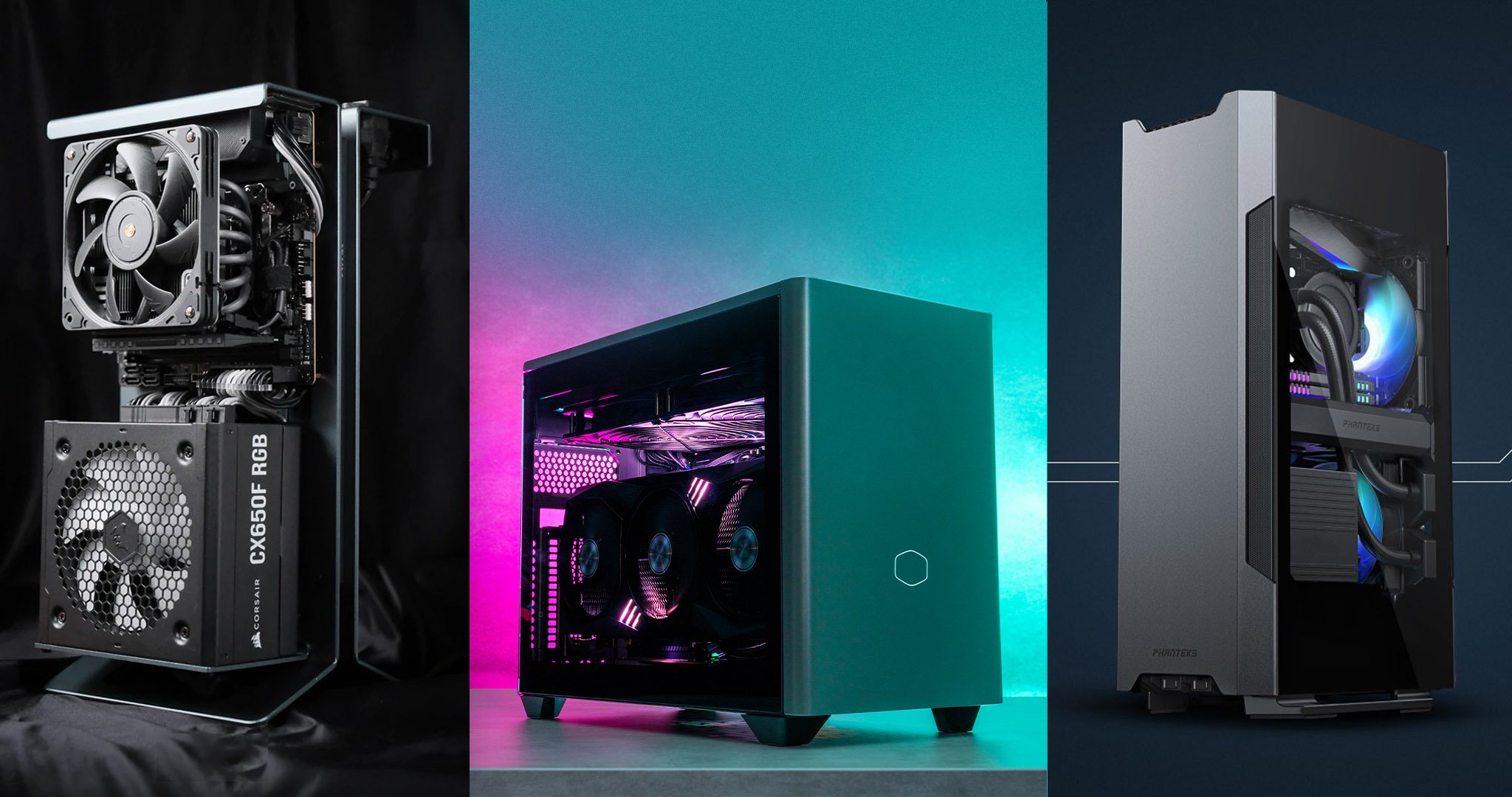
Source: XTIA, CoolerMaster, Phanteks
It is a tremendous challenge and is, therefore, a lot more interesting than it might seem at first glance.
It’s not the kind of PC novice builders tend to go for when they’re first starting out as it presents a series of layered obstacles one has to tackle — and it’s a fair bit more expensive, too.
An ITX motherboard, for instance, is much harder to manufacture and is always sold at a premium. The same goes for SFX power supplies, compact aftermarket coolers, and fancy enclosures that are sometimes so expensive you’ll wonder who would ever be so crazy to buy them.
But that, too, gives it a special kind of appeal. It’s an enthusiast thing, frankly, and a niche that isn’t for those who tend to get seized by vertigo whenever they see obscenely high MSRPs.
Fortunately, the process of building a PC (no matter its size and complexity) is versatile enough that it can “accommodate” vastly different philosophies and methods.
Some might want the biggest possible PC money can buy. Others, however, prefer the “middle ground,” a computer that is small enough to not get in the way but still offers ample flexibility when it comes to the kind of hardware they can cram inside.
Then there’s the ITX bunch: folks who spare no expense in their attempt to shrink down their builds to just a “handful” of liters.
There’s something for everyone, as they say, and even though small form factor PCs might not be your cup of tea they’re still an endlessly interesting option — one that is more than worthy of your undivided time and attention.
Now, you might be wondering: why would someone go out of their way to build such a thing?
ITX PC — Biggest Benefits
There are many benefits to building a small form factor PC, even though — to the uninitiated — they might not be all that obvious or easy to grasp.
Smaller PC = More Free Space
The one reason that is most often cited by ITX aficionados is the amount of space they get when opting to build a smaller computer.
SFFPCs take up a lot less room than their more sizable “counterparts.” That is the biggest and most obvious benefit and, frankly, it’s not a negligible one.
It’s a huge “quality of life” improvement and it’s hard to fully understand just how big of an impact it can make until you see the difference in volume between, say, a mid-tower and an ITX case (to say nothing of ATX behemoths).
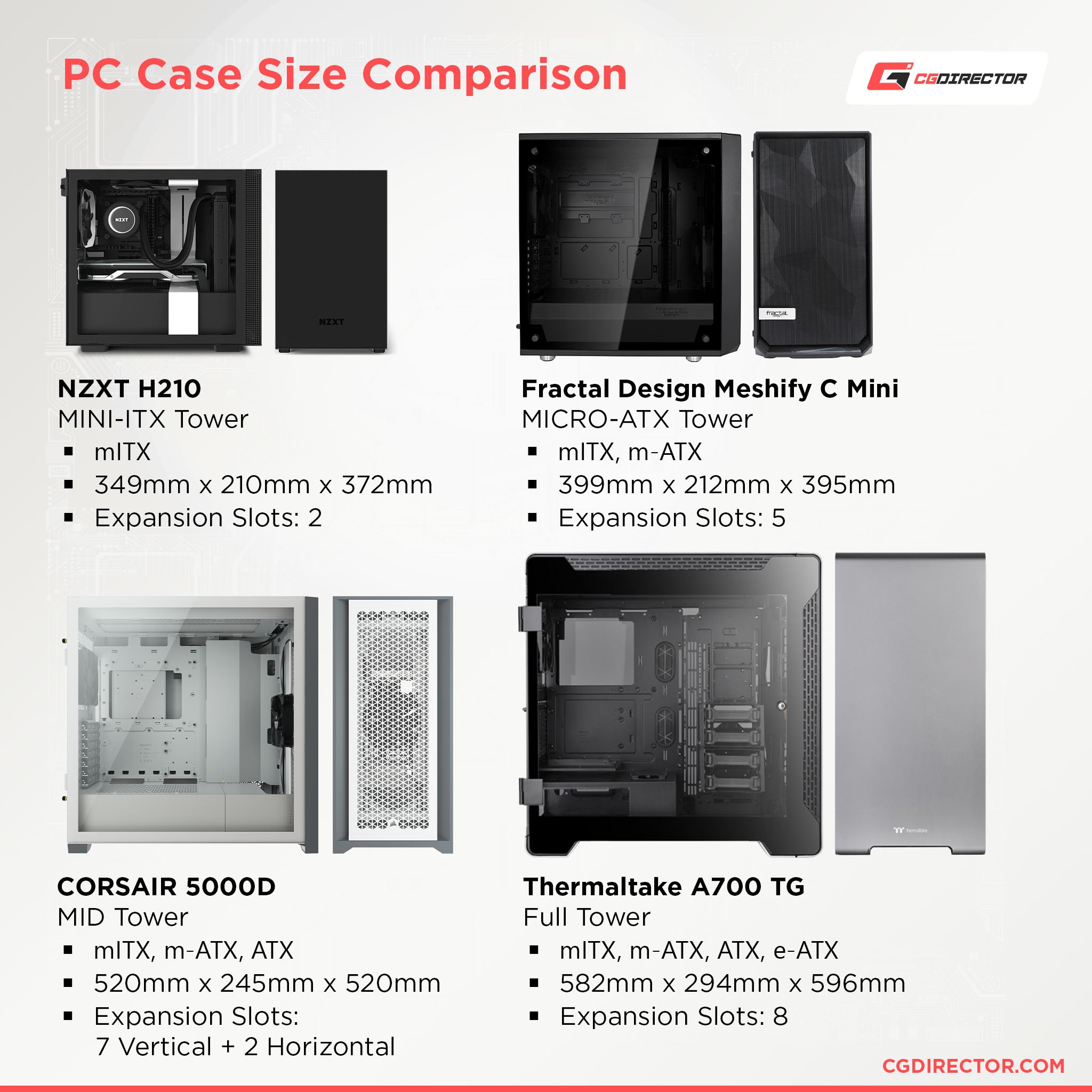
We’ve all grown up thinking that computers have to be humongous hunks of metal with the largest of coolers and a million cables sticking out.
The bigger the better, if you will. But the technology itself has advanced to such a degree that you can actually get the exact same performance in a build that is many times smaller.
And that, in short, is what’s most alluring about ITX computers and small form factor PCs. They don’t compromise on power and are yet a lot more sleek and slender, they’re easier to handle and position — they don’t get in the way.
Now, before we delve any deeper, it’s important to make a key distinction:
ITX vs. SFFPC
Some people tend to use these terms interchangeably, but there is a pretty big difference between them.
An ITX computer has an ITX-sized motherboard deep within its enclosure, but that doesn’t, however, mean that it’s small in size. You have many ITX cases that are well over twenty liters in volume.
An SFFPC, on the other hand, retains the same motherboard format but is compact and relatively portable.
There’s no official definition per se, but most folks agree that anything under twenty liters can be considered an SSFPC.
There are many such cases on the market and they range from a meager 3.9L (in the case of the Velka 3) all the way up to 18 liters.
The smallest ones require Flex ATX power supplies whereas their more sizable “brethren” allow for more flexibility in that regard — they can accommodate larger PSUs, namely those that fall under the SFX and SFX-L categories.
It’s also worth noting that there’s a world of difference between, say, an eight-liter case and one that is thirteen liters in volume.
Two cases can, by all means, have the exact same hardware compatibility but still vary in size. In other words: the SFFPC space is jam-packed with quirky options, some of which aren’t all that well optimized in terms of space and airflow.
You should, therefore, do your due diligence and research whatever is available in your region before pulling the proverbial trigger.
ITX Builds Are A Challenge
Regular-sized builds are somewhat “passé” these days.
They’re still a stellar option from a price-to-performance standpoint but they’ve been around for what feels like an eternity and are, as a result, relatively “boring.”
ITX ones, on the other hand, are not only smaller in size but also present a series of unique challenges one has to overcome.
It’s not as simple a process as it might seem, and successfully navigating it always results in a truly unique kind of exhilaration.
And the smaller you go (in terms of size and volume) the bigger this challenge becomes (and, by proxy, the emotional pay-off once everything is said and done).
So if you love to tinker with your hardware and fine-tune things in an attempt to make everything run optimally, building an ITX PC should definitely be at the top of your list of priorities!
The “X-Factor”
ITX builds are currently “in vogue.”
There’s something inherently alluring in having a computer that is as large as a small pile of books — whilst housing a beastly processor, ample RAM, and a graphics card powerful enough to churn through any video game or workload you might throw its way.
These builds are also somewhat expensive and, as a result, have a sort of premium vibe to them. And, well, who wouldn’t want to have something unique sitting on their desk?
You feel like you’re a part of an exclusive club, one that only you and a handful of other people know about.
It’s a niche thing, obviously, but it has amassed a sizable following over the years for a very good reason.
ITX Builds Are Portable
A regular-sized PC is often hard to move and even harder to transport from one place to another. It’s not impossible, obviously, but it is a hassle that requires ample planning.
ITX builds, on the other hand, can often fit in your backpack.
Now, whether that’s a benefit worthy of mentioning depends solely on your needs and wants, but it is a unique feature, one that some folks care about a great deal.
ITX PCs — Biggest Drawbacks
Smaller PCs do have certain drawbacks but they’re not necessarily dealbreakers — it all depends on your personal preference.
Still, these “quirks” and (potential) inconveniences definitely need to be highlighted.
Hardware Compatibility
With ITX builds, you can’t just go out and buy any kind of hardware — there are numerous size-related limitations and constraints you simply have to keep in mind from start to finish.
Most ITX cases require low-profile coolers and, more often than not, the smallest of GPUs.
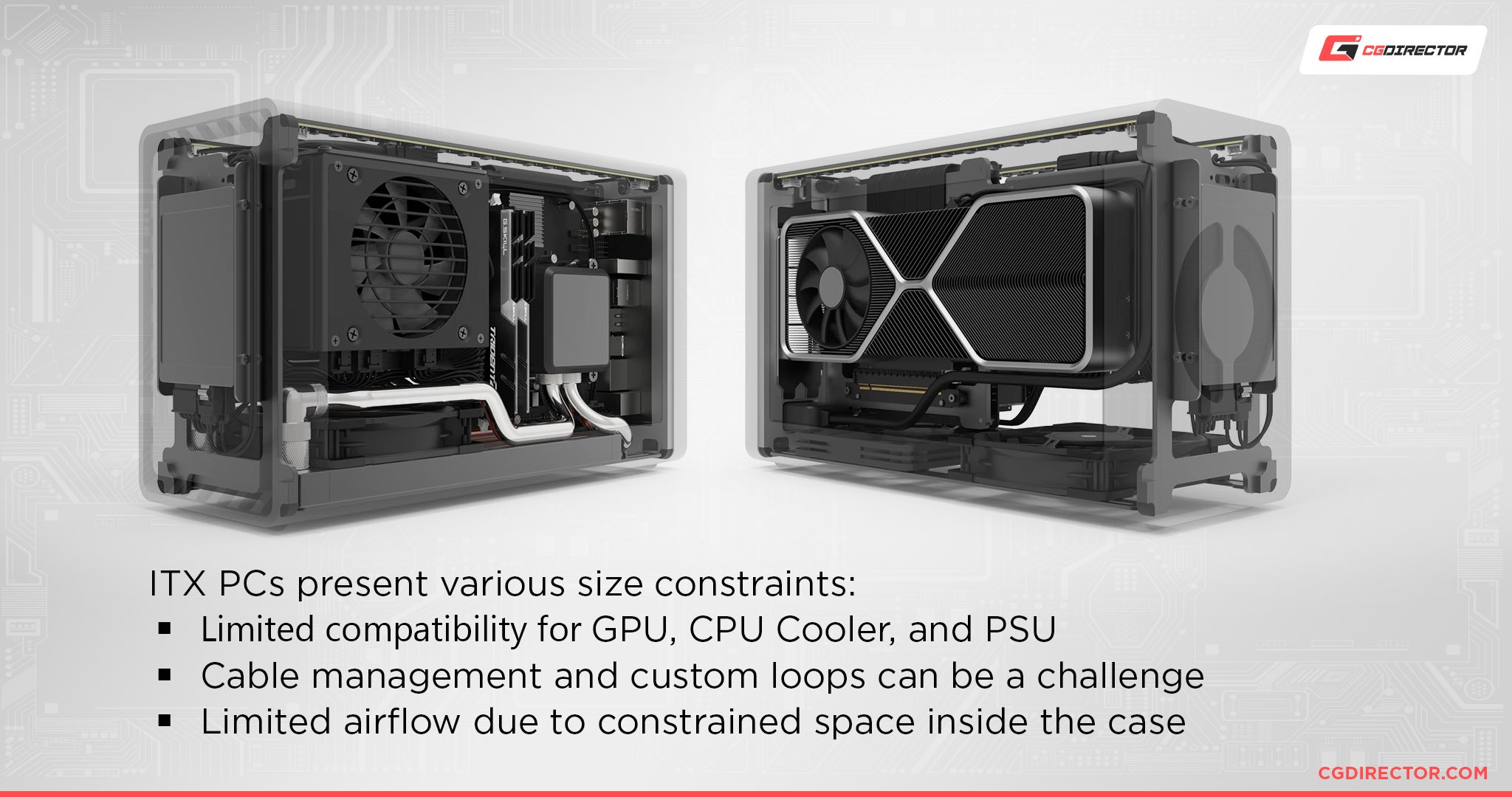
Source: Thor Zone
Now, to be fair, there are certain cases on the market that aren’t as limiting (like the wildly popular Cooler Master NR200P) but at almost 20L in volume, they’re borderline SFFPC.
The smaller you go the more you’re going to have to invest and/or cherry-pick your hardware; the choice, ultimately, is yours.
It’s Too Expensive
ITX components are expensive. There’s really no other way to say it.
Whether they’re worth the asking price will depend on what exactly you’re after and, perhaps above all, the depth of your wallet.
SFX power supplies are often way more expensive than regular ATX ones and don’t even get us started on ITX cases — they can retail for upwards of $200, depending on the model and its manufacturer.
These kinds of builds are not for the budget-minded.
Optimization
A smaller enclosure brings with it a series of challenges. You need to think about hardware compatibility and certain thermal constraints.
Will your components of choice be able to “breathe” within such a petite set-up?
Will your hardware thermally throttle? What about airflow?
Do you need any additional fans so as to ensure better cooling and, if so, how many?
Building an ITX PC requires a fair bit of tinkering both pre- and post-purchase. You don’t necessarily have to roll up your sleeves and optimize your set-up, but in that case, you could run the risk of losing out on performance.
For some, it is a hassle of unfathomable proportions. For others, however, it is a challenge worthy of their time and attention — a hobby, even.
If you spend the vast majority of your time in front of a computer, then why wouldn’t you tinker with it and, in doing so, make sure it performs at its best?
Top ITX Cases in 2022
Conjuring up a listicle of this kind is always a tremendous challenge as the ITX market is ever-evolving.
Certain trends come and go, new “fads” take their place, and there’s always something novel and highly idiosyncratic to talk about.
Be that as it may, certain ITX cases have stood the test of time and are, therefore, more than worthy of your time and attention.
Dan A4-SFX
The enclosure that “started it all.” The A4-SFX is as legendary a case as they come and at just 7.2l in volume, you’ll be able to bring it with you wherever you go.
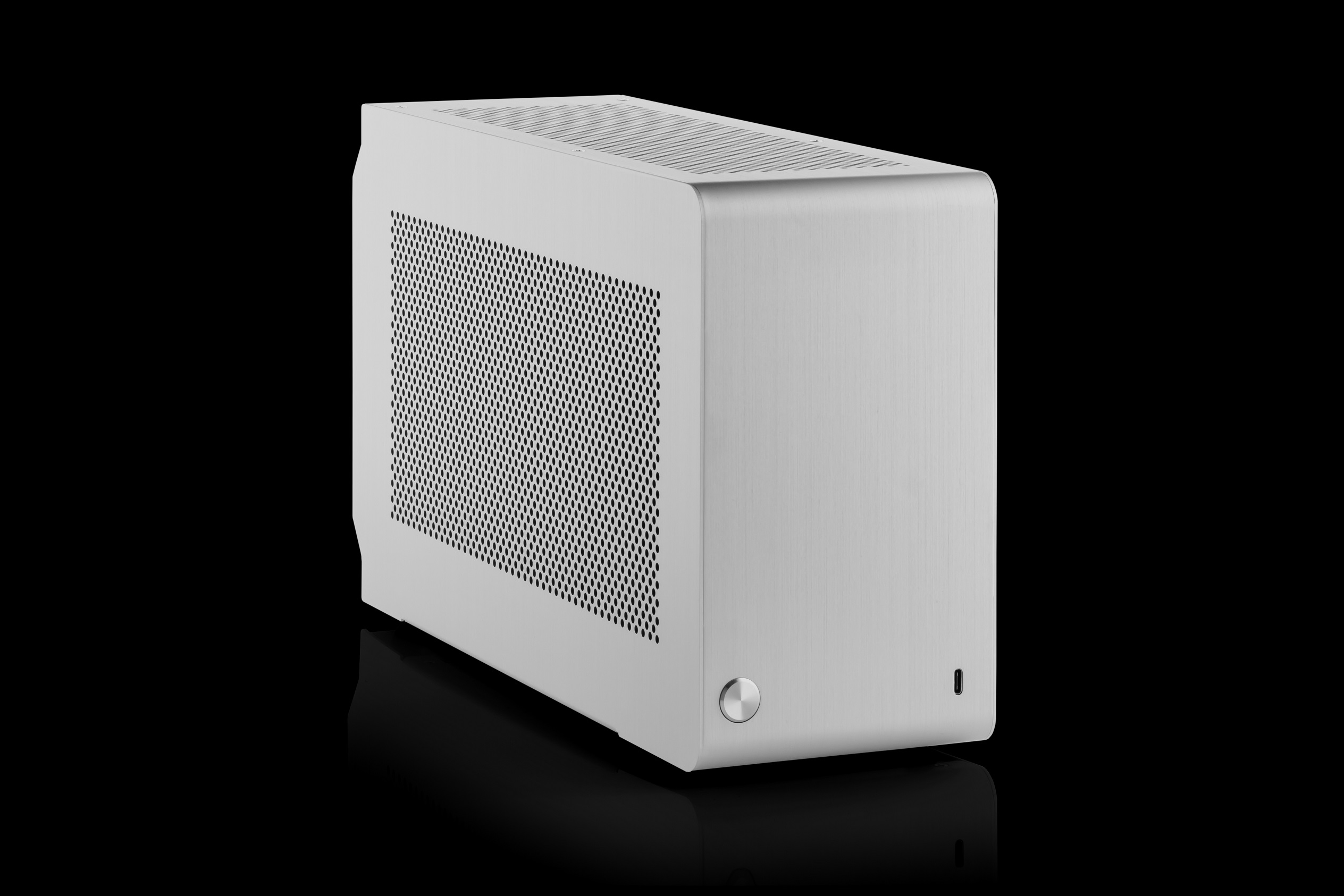
Image Credit: Dan Cases
And, on the off chance, you’re not the traveling type, it’s small enough (not to mention beautiful) to fit in any kind of set-up.
It might not have the best airflow overall — a well-known flaw of its “sandwich” layout — but it’s still a case worth considering.
NZXT H1
A polarizing case, no doubt, but also an astonishingly attractive one as well. It’s just the right size at 13.6 liters and comes with a beefy power supply and a 140 AIO.
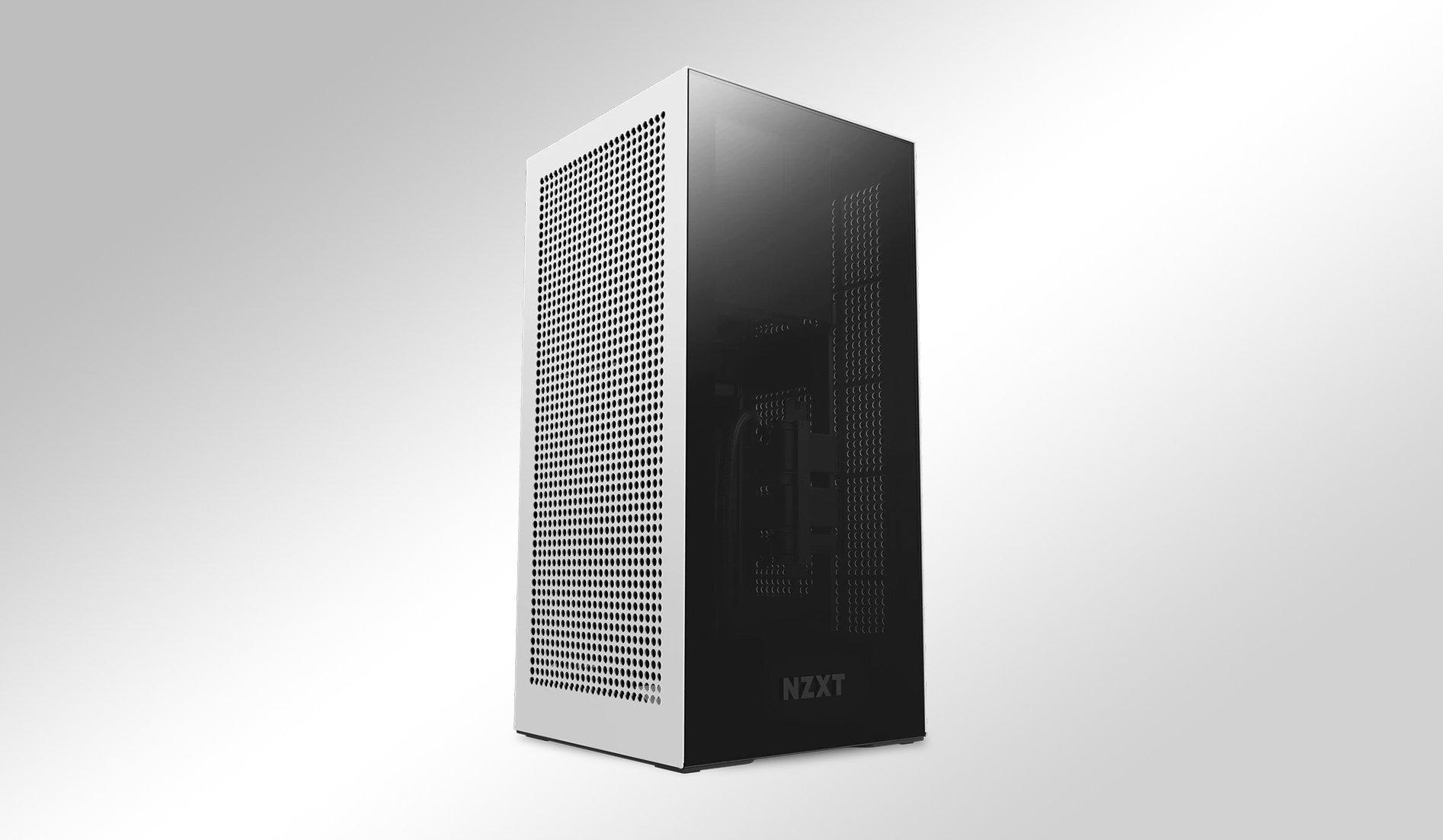
Image Credit: NZXT
And, better yet, it’ll support graphics cards up to 305mm in length which means you’ll have a broader range of GPUs to choose from.
It’s also one of the few cases on the market that are sold as a “kit” — all you need is a CPU, motherboard, RAM, GPU, and storage and you’ll be good to go.
The building process is also amongst the most enjoyable as all the necessary cables are pre-routed. Building in the H1 is like assembling Legos.
There’s also a slightly larger variant (H1 V2) that offers even better GPU compatibility so definitely make sure to give that one a look if you happen to be sporting a triple-slot behemoth.
Cooler Master NR200P
This case is the “jack of all trades.” If you want a small(ish) ITX PC — one that isn’t going to break the bank — the NR200P should be at the top of your list of priorities.
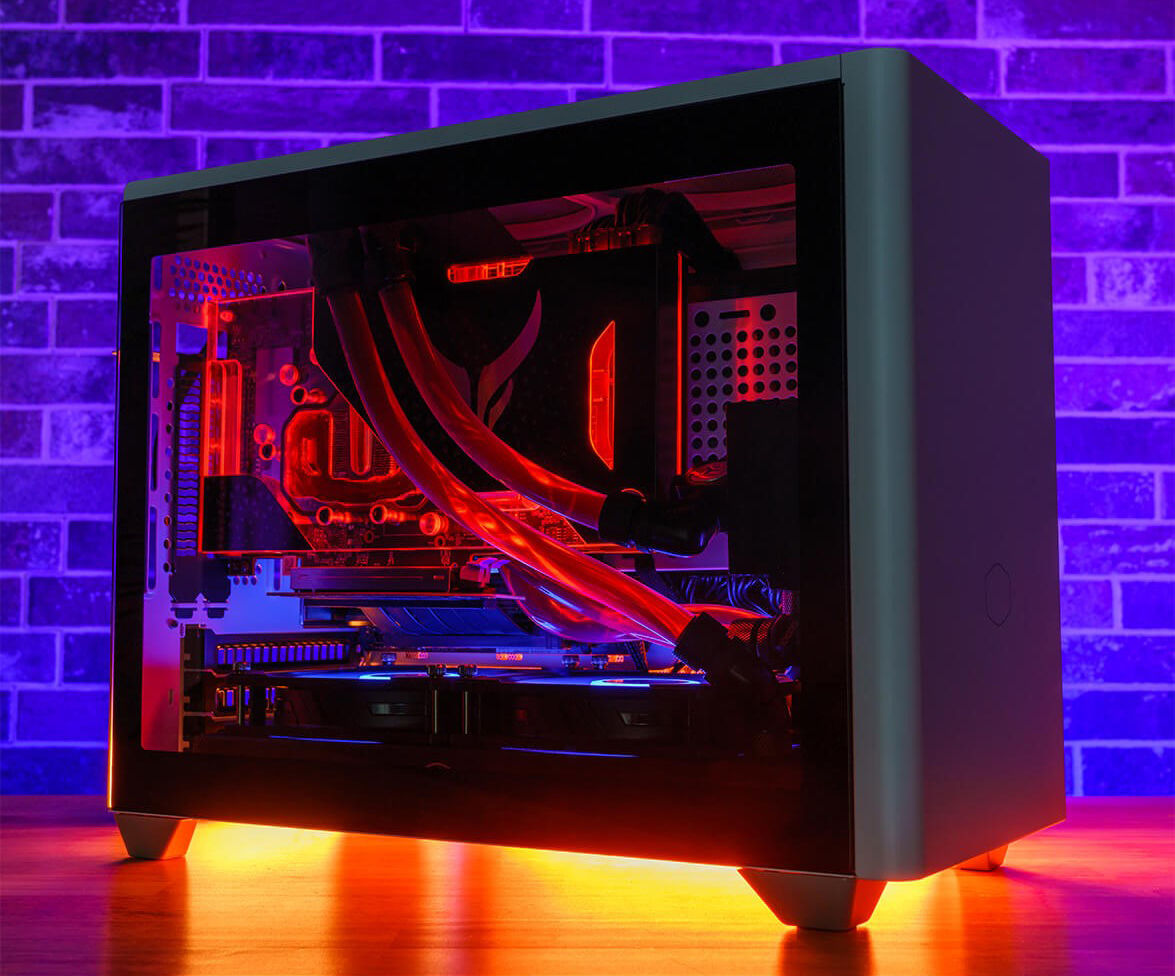
Image Credit: CoolerMaster
The case itself is incredibly cheap for what it is and it also offers mind-blowing hardware compatibility. It is, in a way, the perfect middle ground.
Heck, you can even 3D print a PSU bracket and use a regular ATX power supply — the interior of the case is that “malleable!”
At 18 liters, however, it’s definitely large enough to stretch the definition of SFFPC. That being said, it’s not humongous by any means and is one of the most popular ITX cases on the market for a very good reason.
SSUPD Meshilicious
Yet another truly spectacular entry, one that is designed by a daughter company of Lian Li (which means it brings exceptional build quality and immense attention to detail).
It is a 14.6-liter enclosure that takes the very best bits from NZXT’s H1 and trims some of its “fat.”
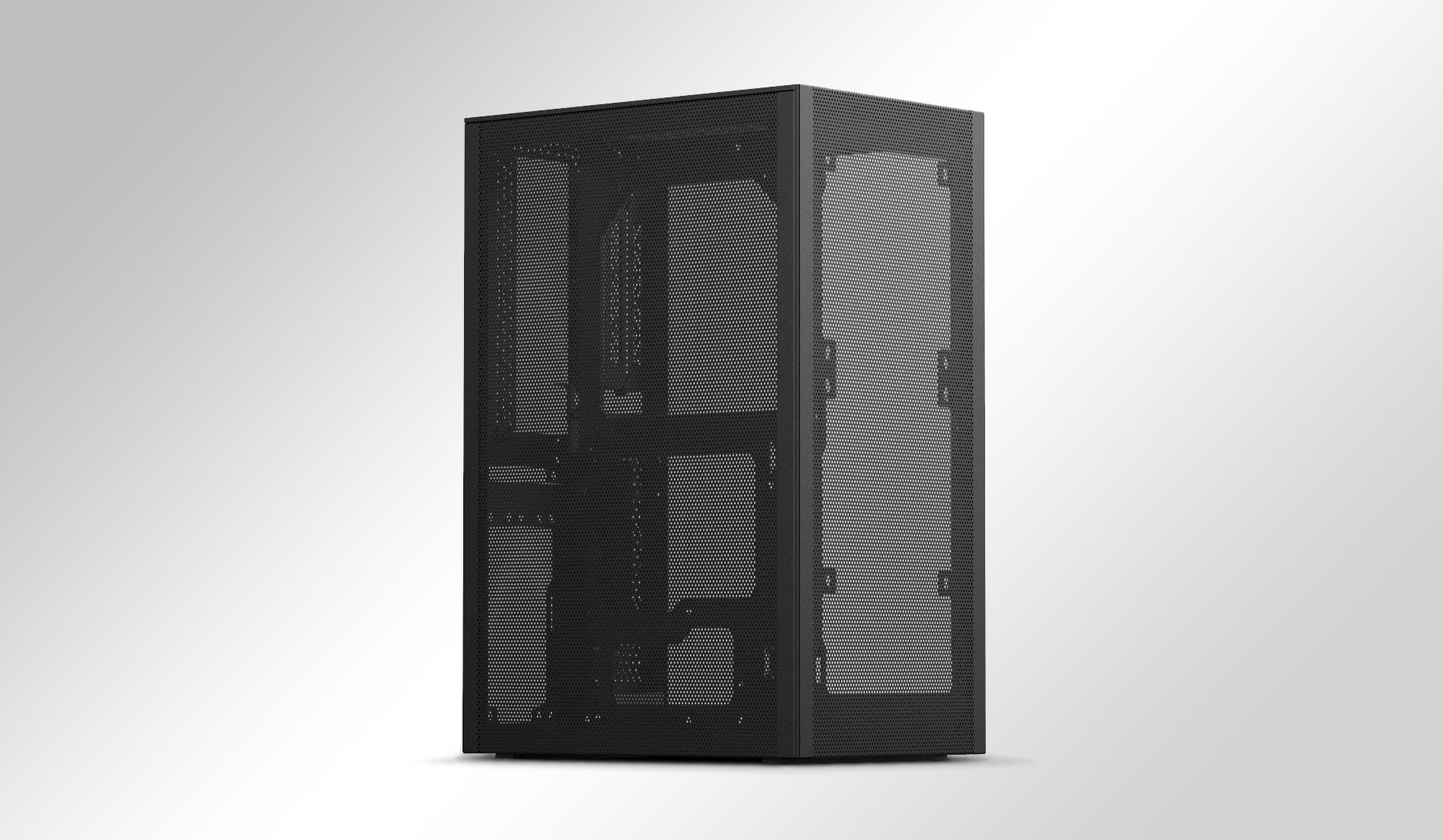
Image Credit: SSUPD
It’s a “barebones” kind of case, however, which is probably what most builders need and want. It has full mesh side panels which result in some truly amazing airflow.
SSUPD has also taken a very original approach — relative to other vertical ITX cases — and has positioned the motherboard in a more natural orientation by folding the included PCIe riser cable.
It also supports up to 280 AIO coolers and full-sized ATX power supplies which is quite a rarity in the sub-15 liter segment of the market.
And, perhaps best of all, it is a “mainstream” case which means it’s readily available in many different markets across the globe which, sadly, isn’t always the case with these niche ITX enclosures.
Dan A4-H20
A collaboration between the creator of the original Dan case and Lian Li. It’s 11 liters in volume, has 240 AIO support, and can handle up to a triple-slot GPU. What more could you ask for?
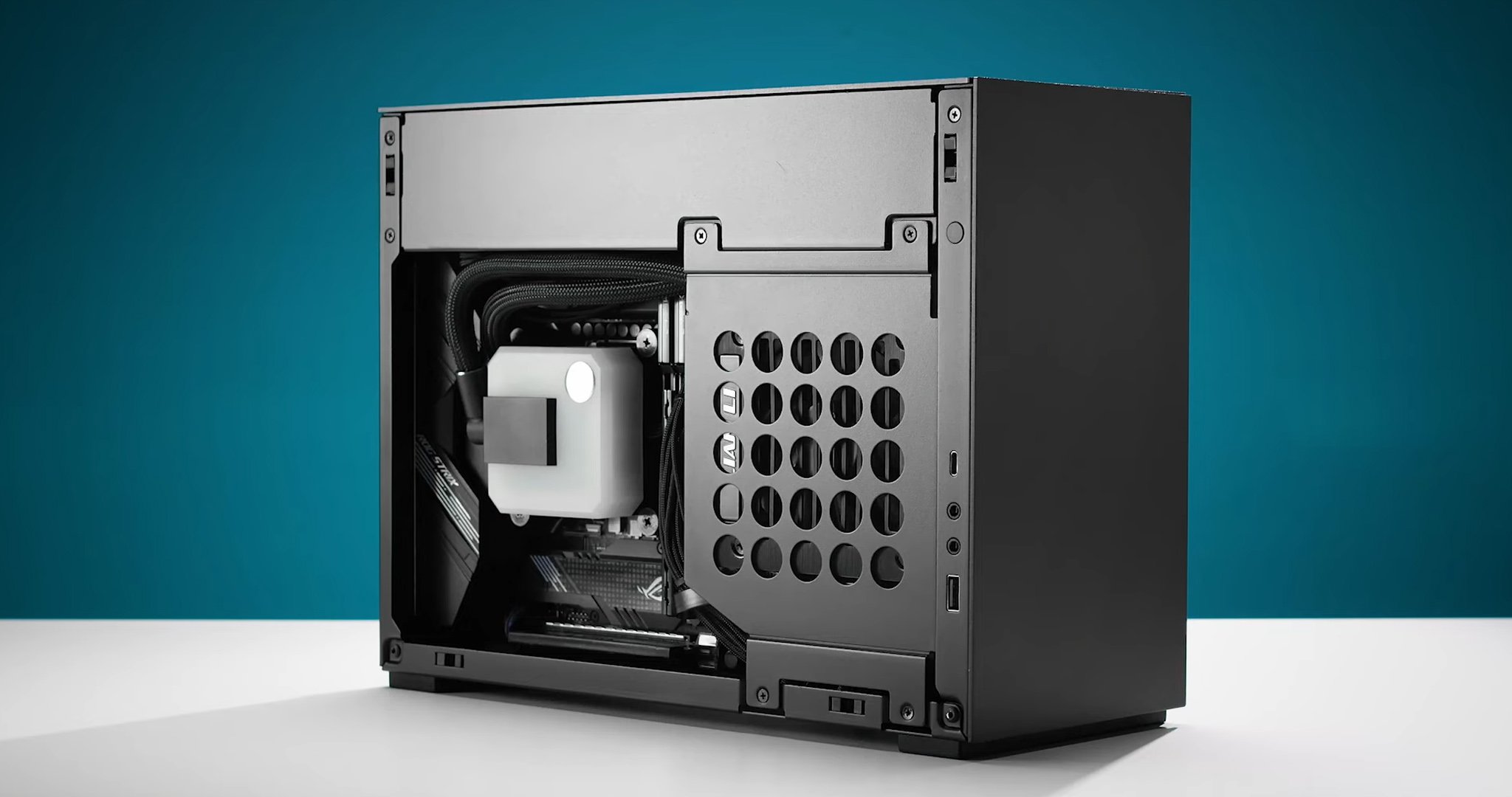
Image Credit: Lian Li
This exceptional case makes no compromises whatsoever and for that, it’s more than worthy of being on our list.
As one reviewer so eloquently put it, it’s about as small as you can get volume-wise without making any sacrifices when it comes to performance and thermals, and it’s also surprisingly “affordable,” too (compared to other niches ITX offerings).
FAQ
Let’s go over a few potential questions you might have when it comes to small form factor PCs and ITX builds in general.
Are ITX Builds Worth It?
Well, that’s quite a hard question to answer as it varies from one person to the next.
Are ITX builds a smart investment from a price-to-performance standpoint? Not in the slightest.
They are, however, a unique option that offers an incredible amount of convenience. So if that’s something you need (or want), then building an ITX PC is definitely a worthwhile endeavor.
Are ITX PCs More Expensive?
They’re always more expensive, unfortunately.
You’re still using the exact same processors, RAM, graphics cards, and storage, but you will have to splurge a bit more on an ITX motherboard and a minuscule little power supply. And, well, SFFPC enclosures also sell at a premium.
You can, however, find them for cheap on the second-hand market if that’s something you’d be willing to entertain.
It can get quite expensive, as you can imagine, but to some, it’s actually worth it.
If I Build an ITX PC, Will I Lose Out on Performance?
If you pick the right components and make sure your case has good enough airflow you’re not going to lose out on performance compared to a regular-sized mATX/ATX build.
That being said, each enclosure brings with it a series of challenges and some of them are downright impossible to tackle.
That’s why it’s always best to go for a case that’s no smaller than, say, eleven or twelve liters as that’s arguably the smallest you can go without making any kind of compromise in terms of hardware compatibility and airflow.
Is ITX Better Than ATX and mATX?
Not at all — it’s just smaller and more premium.
You’re actually getting fewer ports and expansion options which is definitely a drawback inherent to the form factor — and there’s no circumventing it, so just keep that in mind.
What’s the Smallest ITX Case on the Market?
The smallest SFF PC enclosures — ones that can actually accommodate a dedicated graphics card — hover around the three-liter mark.
They’re astonishingly compact but they do bring numerous limitations: you’ll need either a Flex ATX power supply or a picoPSU (depending on how small you want to go), a highly compact CPU cooler, a single-slot GPU, and maybe even some low-profile RAM memory.
That, one could argue, is too small. There are simply too many compromises, although they, too, might be acceptable to those who want to build the absolute smallest ITX PC money can buy.
Over to You
Are you a member of the (surprisingly fervent) ITX community or are you, perhaps, only now looking to downsize your PC? Let us know in the comment section down below, and in case you need any help, head over to our forum and ask away!
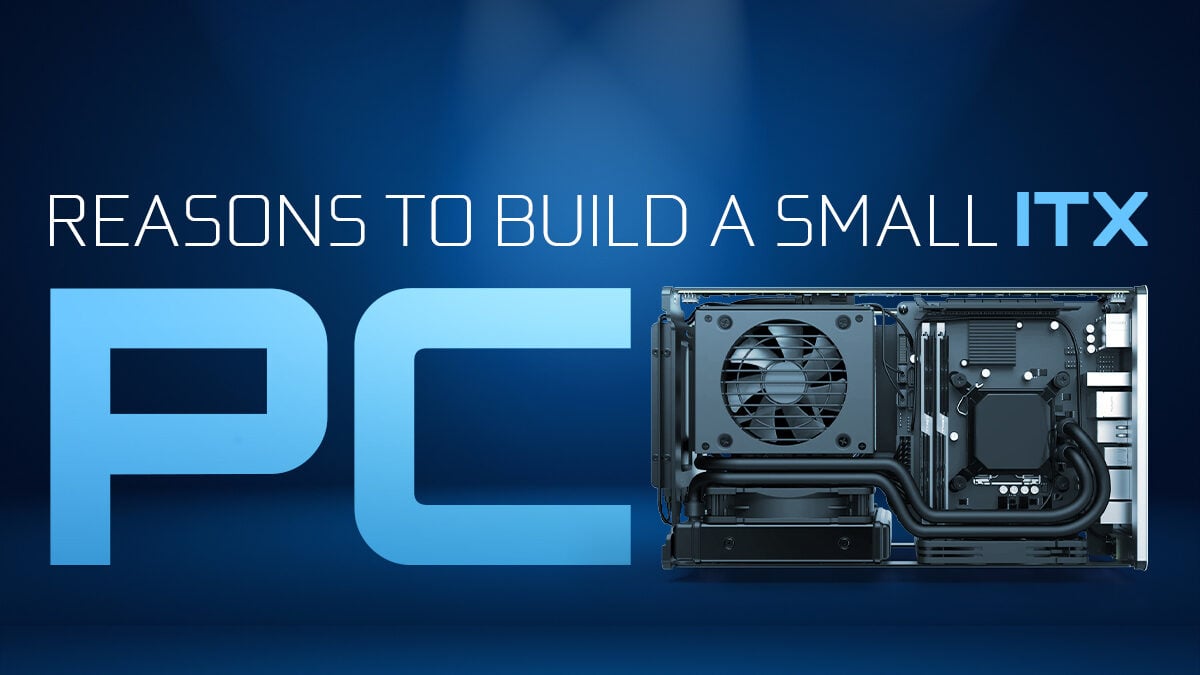
![Should You Build a PC? [7 Great Reasons] Should You Build a PC? [7 Great Reasons]](https://www.cgdirector.com/wp-content/uploads/media/2023/11/Should-You-Build-a-PC-7-Reasons-For-Building-a-PC-Twitter-594x335.jpg)
![Is GIGABYTE a Good Brand? [2024 Update] Is GIGABYTE a Good Brand? [2024 Update]](https://www.cgdirector.com/wp-content/uploads/media/2023/07/Is-GIGABYTE-a-Good-Brand-Twitter-594x335.jpg)
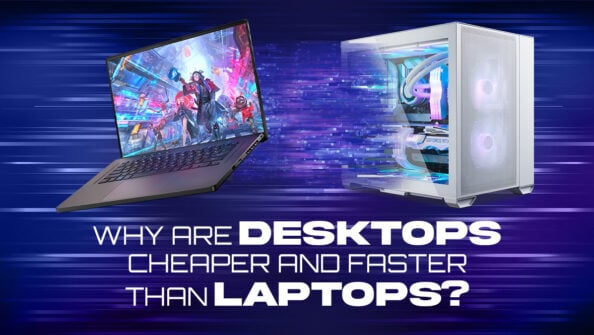
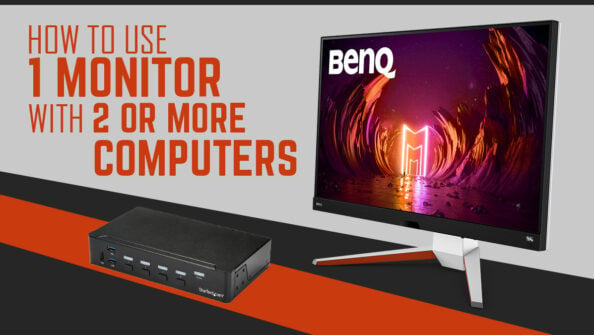

0 Comments